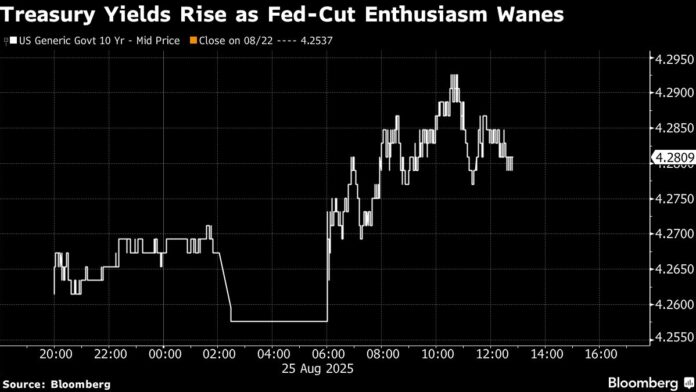(Bloomberg) — A rally that put stocks on the brink of all-time highs sputtered and bond yields rose as euphoria around Federal Reserve rate cuts eased ahead of a key inflation reading.
While Jerome Powell on Friday signalled a September rate cut is likely on the way amid downside risks to jobs, doubts over the pace of those reductions lingered on Wall Street. In addition to officials remaining divided, traders are bracing for a not-so-friendly price reading later this week.
Subscribe to the Stock Movers Podcast on Apple, Spotify and other Podcast Platforms.
Policy-makers are grappling with inflation that’s still above their 2% goal — and rising — and a labour market that’s showing signs of weakness. That unnerving reality, which pulls policy in opposite directions, is made worse by a high degree of uncertainty about how each of those factors will evolve over the coming months.
The Fed’s preferred measure of underlying inflation probably ticked higher last month, with the personal consumption expenditures price index excluding food and energy rising 2.9% from a year ago. That would be fastest annual pace in five months.
“Now the discussion will likely turn to how aggressive the Fed may be,” said Chris Larkin at E*Trade from Morgan Stanley. “Signs of a slowing labour market currently appear to be outweighing inflation concerns, but the Fed hasn’t abandoned its 2% target.”
The S&P 500 fell 0.1%. While about 400 shares dropped, Nvidia Corp. paced gains in megacaps ahead of its results. The yield on 10-year Treasuries rose one basis point to 4.27%. French bonds slid as Prime Minister Francois Bayrou said he’d call for a confidence vote over the budget.
Money markets are pricing in roughly 80% odds of a Fed rate cut in September, and a total of two reductions by the end of the year.
To Krishna Guha at Evercore, the repricing of a September rate cut after Powell’s Jackson Hole speech Friday was “not excessive.”
“If we are right, the focus shifts to what happens after September,” Guha said. “If the next set of labour data is not too bad, we think the Fed will begin to frame out the cautious recalibration cut, while seeking to contain expectations of ‘too much too soon’.”
Where do we go now?
“Our view is the low yield levels of Friday should be faded,” Andrew Brenner at NatAlliance Securities. “While we still see the Fed cutting in September, we now have to figure out whether it will be a ‘dovish cut’ or a ‘hawkish cut.’ We don’t want one to think that inflation is not that important, but the real unknown risk to the economy is the employment situation.”
The exact path forward, particularly the pace of rate cuts, is still up for debate as Fed officials hold diverging views on the potential impact of tariffs and the overall state of the economy, according to Jason Pride and Michael Reynolds at Glenmede.
“Upcoming leadership changes at the Fed may mark a dovish shift over the long-term, with most candidates under consideration for chair broadly viewed as more accommodative than Powell,” they said.
National Economic Council Director Kevin Hassett indicated President Donald Trump’s decision on who should succeed Powell is months away. His term as Fed chair is set to expire in May.

“We expect Powell to advocate for easing at the September meeting unless incoming data, such as a strong August labour report or higher-than-expected inflation, provide reason to stay on hold,” said Ulrike Hoffmann-Burchardi at UBS Global Wealth Management. “Against this backdrop, we anticipate four quarter-point rate cuts through January 2026, starting in September.”
Investors will also monitor comments from Fed officials at public events this week to gauge their appetite for a September rate cut. Governor Christopher Waller and regional Fed bank presidents John Williams, Lorie Logan and Tom Barkin are all scheduled to speak.
“We also look for Fedspeak this week to generally echo Powell’s view that the Fed can ease in September on shifting concerns towards the labor market,” said Oscar Munoz and Eli Nir at TD Securities.
At Glenmede, the strategists noted that resuming the rate cut cycle will likely be a tailwind for bonds. Fixed income may offer upside potential for investors as yields across major fixed income categories remain near fair value.
“Small caps may stand to benefit most from easing, with more than half of their debt charging floating rate interest,” they said. “Lower interest expenses could notably lift earnings, potentially setting the stage for a small cap comeback into year-end.”
Some of the main moves in markets:
Stocks
- The S&P 500 fell 0.1% as of 2:01 p.m. New York time
- The Nasdaq 100 was little changed
- The Dow Jones Industrial Average fell 0.6%
- The MSCI World Index fell 0.3%
- Bloomberg Magnificent 7 Total Return Index rose 0.8%
- The Russell 2000 Index fell 0.6%
Cryptocurrencies
- Bitcoin fell 0.4% to $112,305.89
- Ether fell 4.3% to $4,579.75
Bonds
- The yield on 10-year Treasuries advanced one basis point to 4.27%
- Germany’s 10-year yield advanced four basis points to 2.76%
- Britain’s 10-year yield was little changed at 4.69%
Commodities
- West Texas Intermediate crude rose 2.1% to $64.97 a barrel
- Spot gold was little changed
©2025 Bloomberg L.P.
Visited 1 times, 1 visit(s) today
bloomberg Dashboard economic news federal reserve jerome powell markets wrap rate cut forecasts stocks US fed
Last modified: August 25, 2025
